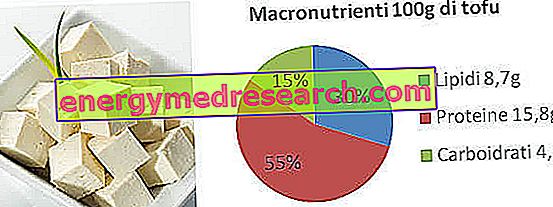Tofu and miso are food products derived from the seeds of Glycine max, a leguminous plant commonly known as soy.
Tofu
The first literary traces that describe the soy plantations (known as ta-tou or big bean) date back to around 3, 000 BC; the tofu appeared only 3000 years later (around the year 0), thanks to the technical and alimentary ingenuity of a Chinese monk-alchemist: Li An.
Following its discovery, tofu was widespread in all regions and neighboring countries (including Japan), mainly thanks to the emigration of Buddhist monks, philosophers and great culinary artists.
Tofu - How to do it at home
X Problems with video playback? Reload from YouTube Go to Video Page Go to Video Recipes Section Watch the video on youtubeTofu: unique food of its kind
The first aspect that characterizes tofu is the relationship between raw material and finished product; it is a food obtained from a VERY HIGH PROFITABILITY process and, in practice, it is possible to estimate that the tofu is characterized by a weight of the finished product almost identical to that of the raw material.
Secondly, the characteristic of greater digestibility is also appreciable; in fact tofu, unlike most of the products obtained by processing / food derivation, is a food that increases the potential for digestibility of the raw material used. Put simply, tofu is more digestible than soy itself!

| Nutritional composition of solid tofu produced with calcium sulfate | ||
| Power | KCal | 145 |
| water | g | 68.9 |
| proteins | g | 15.8 |
| Lipids | g | 8.7 |
| Saturated | g | 1:26 |
| Monounsaturated | g | 1.93 |
| polyunsaturated | g | 4.92 |
| B.C. Linoleic | g | 4:34 |
| Ac Linolenico | g | 00:58 |
| Cholesterol | mg | 0 |
| carbohydrates | g | 4.3 |
| Simple | g | 0.0 |
| Fiber | g | 2.3 |
| Sodium | mg | 14 |
| Potassium | mg | 237 |
| Football | mg | 683 |
| Phosphorus | mg | 190 |
| Iron | mg | 2.66 |
| Thiamine | mg | 0158 |
| Riboflavin | mg | 0102 |
| Niacin | mg | 0381 |
| Retinol | mcg | 166 |
Another peculiarity of tofu is that it is produced through a processing technique very similar to cheese making. For the production of tofu, soy only "milk" is used, a white and milky high-protein extraction liquid that agglomerates consequently to curdling (introduction of rennet consisting of citric acid or nigari).
To be precise, "tofu" is not a Chinese term but Japanese and means "meat without bones". However, tofu has nothing to do with meat ... nor with cheese, with which it ONLY shares the appearance but absolutely NOT the taste. From the organoleptic point of view, it is possible to state that tofu is a unique food and hardly comparable to other foods of western derivation.
Although it is a valid alternative to foods of animal origin, thanks to its high protein intake and the absence of cholesterol, tofu is not able to replace them completely due to its total deficiency in cobalamin (vit. B12) and colecalciferol ( vit. D).
Tofu boasts all the nutritional characteristics of soy (cholesterol-lowering lecithin, polyunsaturated fatty acids, etc.) associated with a more than satisfactory digestibility.
Miso
Miso is a fermented pasta obtained mainly from soybean processing; despite being a food originating in China, miso was imported into Japan in the 13th century, where it quickly spread and became firmly rooted in the food culture of all regions. Even today, the elderly and Japanese monks suggest starting the day with a portion of rice and miso and a cup of homemade sake.

| Nutritional composition of miso soup | ||
| Power | KCal | 199 |
| water | g | 43.0 |
| proteins | g | 11.7 |
| Lipids | g | 6.0 |
| Saturated | g | 1:14 |
| Monounsaturated | g | 1:24 |
| polyunsaturated | g | 3:20 |
| B.C. Linoleic | g | 2.75 |
| Ac Linolenico | g | 00:45 |
| Cholesterol | mg | 0 |
| carbohydrates | g | 26.5 |
| Simple | g | 6.2. |
| Fiber | g | 5.4 |
| Sodium | mg | 3728 |
| Potassium | mg | 237 |
| Football | mg | 57 |
| Phosphorus | mg | 159 |
| Iron | mg | 2:49 |
| Thiamine | mg | 0098 |
| Riboflavin | mg | 0233 |
| Niacin | mg | 0906 |
| Retinol | mcg | 87 |
Miso is obtained from the fungal fermentation of soybeans and / or rice and barley in salted water, for a period ranging from 12 to 24 months; the organism responsible for the chemical transformation of the food is Aspergillus oryzae which, thanks to the molecular hydrolysis of carbohydrates, favors a pasty consistency (smooth or grainy) and a pigment variegation ranging from red to yellow.
Video Recipes with Miso
Miso soup
Pure miso is a sufficiently proteic food, fairly digestible and strongly energetic but definitely rich in sodium; it is frequently used in dilution with soups but also as a condiment on vegetables and fish. From the nutritional point of view, the miso has all the PRObiotic functions of yogurt and the hypocholesterolemizing ones of soy, thanks to the discrete content in lecithin and polyunsaturated fatty acids. There are 4 types on the market: HATCHO, MUGI, KOME and MISO DI SOLA SOIA.
Miso is a useful food to season other foods; it is a product with a high sodium content, therefore, the abuse (especially of HATCHO miso) is potentially harmful and not recommended in subjects with arterial hypertension. The cobalamin content of miso effectively compensates for the lack of tofu; therefore, by consuming traditional tofu and miso-based soups, a vegan diet would benefit from it by limiting the vitamin integration of vitamin B12 to less consistent doses.



